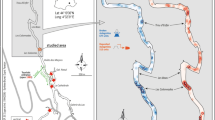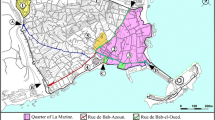Abstract
This paper introduces the importance of geotourism in the area between Susa and Darnah, Al Jabal al Akhdar, Northeast Libya, where a variety of geosites are distributed in a scattered, multiunique panorama. Several field visits in different periods were conducted to perform this work. This study aims to list, categorize, analyze, and illustrate the most prominent and alluring geosites. Moreover, it attempts to establish a geoteroist-road map for these sites as well. The studied geosites are allocated in five geographical districts, which are from west to east Susa, Ras Al Hilal, Al Athrun, Karsah, and Darnah. They are categorized as follows: I—geomorphosites (wadies, dolines, and caves); II—hydrosites (springs, waterfalls); III—tectonosites (folds, faults, earthquakes, and unconformities); and IV—bio/stratosites (fossils and stratigraphy). Seventeen geosites have been inventoried and quantitatively evaluated and found that most moderate to high scientific values characterize these geosites, where Fteah Cave is the highest score of 350. The results of the assessment also show that the geosites have the potential for educational and tourist practices with a score of medium to high values. The degradation risk of geosites scores mostly moderate to high values. The researchers in this study nominate Susa-Al Athrun region as an international geopark. This paper is also alarmed by the expected geohazards in some localities, such as valleys and escarpment sites during the rainy periods.
























Similar content being viewed by others
Data Availability
Not applicable.
Code Availability
Not applicable.
References
Abdulsamad EO, Bu-Argoub FM, Tmalla AF (2009) A stratigraphic review of the Eocene to Miocene rock units in the Al Jabal al Akhdar, NE Libya. Mar Pet Geol 26:1228–1239. https://doi.org/10.1016/j.marpetgeo.2008.06.003
Ahlman HW (1930) La Libia Settentrionale Ufficio Studi, Tripoli, Italian Translation by Dott. Chieze
Ashahomi KA (2008) Karst in Al Jabal al Akhdar. Geology East Libya 4:377–394
Bakar MA, Muftah AM, Shaltami OR (2021) Origin of cherts in Al Jabal al Akhdar, northeast Libya: petrographical and paleontological evidence. Arab J Geosci 14:763. https://doi.org/10.1007/s12517-021-07002-9
Barker G, Hunt C, Reynolds T, Brooks I, el-Rishi H, (2007) The Haua Fteah, Cyrenaica (northeast Libya): renewed investigations of the cave and its landscape, 2007. Libyan Studies 38:93–114
Barr FT, Hammuda OS (1971) Biostratigraphy and planktonic zonation of the Upper Cretaceous Athrun Limestone and Hilal Shale, Northeastern Libya. In: A. Farinacci (Ed.), proc. 2nd. Int. conf. Planktic. Microfossils. Rome, 27–40 pp
Berred S, Berred K, Fadli D (2022a) Geodiversity of Kingdom of Morocco: Tata Province geomorphosites inventory for creating a geopark project (Anti-Atlas). Int J Geoheritage Parks 10(3):367–382
Berred K, Youssi ME, Berred S (2022b) Inventorying Rabat-Salé-Kénitra region’s geological heritage within Central Morocco: a useful tool for developing regional geotourism activity. Geoheritage 14(3):1–18
Brilha JB (2016) Inventory and quantitative assessment of geosites and geodiversity sites: a review. Geoheritage 8:119–134
Capezzuoli E, Gandin A, Pedley M (2014) Decoding tufa and travertine )fresh water carbonates) in the sedimentary record: the state of the art. Sedimentology 61:1–21
Chen A, Lu Y, Ng YCY (2015) The principles of geotourism, Springer Geography, p 264
Desio A (1935) Studi geologici sulla Cirenaica, sul Deserto Libico, sulla Tripolitania e sul Fezzan Oriental. Missione Secintifica della R. Accd. d’Italia a Cufra (1931), Vol. 1, , 60 fig., 6 Pl., 1 carta geol. scala 1:2,500,000, Roma, 480P
Desio A (1968) History of geologic exploration in Cyrenaica. In Geology and Archeology of Northern Cyrenaica (ed. F.T. Barr). Petroleum exploration society of Libya, 10th Annual conference. Pp. 79–113
El-Arnauti A, Shelmani M (1985) Stratigraphic and structural setting. J Micropalaeontol 4:1–10. https://doi.org/10.1144/jm.4.1.11985
El Amawy MA, Muftah AM, Abd El-Wahid MA, Nasar A (2011) Wrench structural deformation in Ras Al Hilal–Al Athrun area, NE Libya: a new contribution in northern Al Jabal al Akhdar belt. Arab J Geosci 4:1067–1085. https://doi.org/10.1007/s12517-009-0114-5
El Arnauti A, Shelmani M (1988) A contributionto the northeast Libyan subsurface stratigraphy withemphasis on Pre-Mesozoic. In: El Arnauti A, Owens B, Thusu B (eds) Subsurface playnostratigraphyof northeast Libya. Garyounis UniversityPublications, Benghazi, pp 1–16
El Arnauti A, Lawrence SR, Mansouri AL, Sengor AM, Soulsby AMC, Hassan H (2008) A structural style in NE Libya. Geology of East Libya, vol 4. Gutenberg Press, Tripoli, pp 153–178
El Hawat AS, Jorry S, Caline B, Davaud E, Masse P (2008) The Ypresian to early Lutetian facies, sequences, and unconformities of Cyrenaica: their correlation and implications in North Africa. Geology East Libya 1:85–120
El Hawat AS, Abdulsamad EO (2004) The geology of Cyrenaica: a field seminar. Proceedings of the 3rd Symposium on the Sedimentary Basins of Libya: Geology of East Libya. Tripoli, Earth Science Society of Libya, 130 pp
El Hawat AS, Salem MJ (1985) Stratigraphic reappraisal of Ar-Rajmah formation, miocene, Al Jabal Al Akhdar, NE Libya: a case of field sedimentological approach. 8th Congress of the Regional Committee on Mediterranean Neogene Stratigraphy. Budapest, Hung. Geol. Surv., p 206–208
El Hawat AS, Shelmani M (1993) Short notes and guidebook on the geology of Al Jabal al Akhdar, Cyrenaica, NE Libya. Essl, Tripoli, p 70
Elwerfalli AO, Muftah AM, El-Hawat AS (2000) A guidebook on the geology of Al Jabal al Akhdar, Cyrenaica, NE Libya. Gutenberg Press Limited- Malta, p 71p
Errishi H, El-Ekhfifi SS, Muftah AM, Elseaiti SO (2020) Highlight the geotourism in the Libyan desert. Iraqi Geological Journal 53(1B):108–120
Fedorov YA, Ruban DA (2019) Geoheritage resource of small mud lakes in the semi-arid environments of the Russian South. Resources 8(2):75
Fuertes-Gutiérrez I, Fernández-Martínez E (2010) Geosites inventory in the Leon Province (Northwestern Spain): a tool to introduce geoheritage into regional environmental management. Geoheritage 2(1):57–75
Garcia, Brilha, de Lima, et al. (2018) The inventory of geological heritage of the state of São Paulo, Brazil: methodological basis, results, and perspectives. Geoheritage, 10 (2018), pp. 239-258. https://doi.org/10.1007/s12371-016-0215-y
GEFLI (1972) Soil and water resources survey for hydro-agricultural development, Al Jabal al Akhdar NE Libya. Water Resources Survey, Hydrology Department, Darnah, Libya
Goodchild R (1970) Cyrene and Apollonia. Tripoli: Department of Antiquities, Libya, p 120
Gray M (2011) Other nature: geodiversity and geosystem services. Environ Conserv 38(3):271–274
Gregory JW (1911) The geology of the Jafreh Gypsum-Anhydrite Deposit, Tripolitania, Libya. U.S. Operations Mission, 64 p., Tripoli. The Kingdom of Libya, Ministry of Industry, Geol. Sec. Bull., Tripoli, 1967 No. 6, 64 p
Hallaq D (1993) Oshas of the Ancestors 2, Mark the saint: a brief study of his biography, his struggle against the Romans, the discovery of his headquarters in the green mountain. Antiquities Authority, Tripoli, Libya (in Arabic) p 231
Hey RW (1956) The geomorphology and tectonics of Jabal Akhdar (Cyrenaica). Geol Mag 93(1):1–14
Joyce EB (2010) Australia’s geoheritage: history of study, a new inventory of geosites and applications to geotourism and geoparks. Geoheritage 2(1):39–56
Joyce EB (2006c) Geomorphological sites and the new Geotourism in Australia. http://web.earthsci.unimelb.edu.au/Joyce/heritage/geotourosmReviewebj.htm
Marinelli O (1920) Sulla morfologia della Cirenaica, Rev. Geog. Ital. pp. 69–86
McBurney CBM (1960) The Stone Age of Northern Africa. Penguin Books, London
McBurney CBM (1967) The Haua Fteah in Cyrenaica. Cambridge University Press, Cambridge
McBurney CB and Hey RW (1955) Prehistory and Pleistocene geology in Cyrenaican Libya. Museum Archeology Ethnology, Cambridge university press 4: 316 p
Megerssa L, Rapprich V, Novotný R, Verner K, Erban V, Legesse F, Manaye M (2019) Inventory of key geosites in the Butajira Volcanic Field: perspective for the first geopark in Ethiopia. Geoheritage 11(4):1643–1653
National Geographic (2005) Geotourism charter, http://www.nationalgeographic.com/ travel/sustainable/pdf/geotourism_charter_template.pdf (accessed 4/1/2009)
Newsome D, Dowling RK (2010) Geotourism: the tourism of geology and landscape. Goodfellow Publishers Ltd, Oxford, p 260
Rocha AJD, Lima E, Schobbenhaus C (2016a) Aplicativo Geossit – Nova versão. In: 48°. Congresso Brasileiro de Geologia, Porto Alegre. Acesso em 20 de outubro de 2017. <http://sbg.sitepessoal.com/anais48cbg/st22/ID6389_111448_52_Aplicativo_geossit.pdf
Rocha AJD, Lima E, Schobbenhaus C (2016b) Aplicativo GEOSSIT – nova versão. In Congresso Brasileiro de Geologia (Vol. 48, No. 2016b, p. 6389)
Rohlich P (1974) Geological map of Libya, 1:250 000: sheet Al Bayda NI 34–15. Explanatory booklet. Ind. Res. Cent., Tripoli.70p
Rohlich P (1980) Tectonic development of Al Jabal al Akhdar. In: Salem, M.J., Busrwel, M.T. (eds.), the geology of Libya, vol.3. academic press, London, pp.923–931
Santi P, Tramontana M, Tonelli G, Renzulli A, Veneri F (2021) The historic centre of Urbino, UNESCO World Heritage (Marche Region, Italy): an urban-geological itinerary across the building and ornamental stones. Geoheritage 13:86. https://doi.org/10.1007/s12371-021-00606-3
Saurabh M, Sudhanshu SK, Sk S, Mathur SC (2021) Qualitative assessment of geoheritage for geotourism promotion: a case study from Mehrangarh Ridge in Jodhpur City, Western Rajasthan, India. Geoheritage 13:80. https://doi.org/10.1007/s12371-021-00604-5
Tessema GA, van Der Borg J, Minale AS, Van Rompaey A, Adgo E, Nyssen J, Poesen J (2021) Inventory and assessment of geosites for geotourism development in the Eastern and Southeastern Lake Tana Region. Ethiopia Geoheritage 13(2):1–23
Vita-Finzi C (1969) The Mediterranean valleys: geological changes in historical times (Incl: Northern Tripolitania and Cyrenaica), 140 p., 4 photos, maps. Cambridge University Press, London
Widrig W (1978) Two churches at Latrun in Cyrenaica. Papers of the British School at Rome 46:94–131
Zert B (1974) Geologic map of Libya, 1:250,000 Darnah Sheet (NI 34–16), Explanatory booklet. Industrial Research Centre, Tripoli, p 49
Acknowledgements
The authors thank everyone who contributed and helped in the production and completion of this paper; their efforts are highly appreciated and highly respected. The authors also thank deeply the professional photographers who shared with us some of their excellent photos. Dr. Hidob Idris is also appreciated for the English review of the manuscript.
Author information
Authors and Affiliations
Contributions
Mohammed F. El Hassi planned for this study, did the fieldwork, take the measurements, took the photographs, describe the geosites, wrote the manuscript and abstract, prepared the figures and tables, reviewed the manuscript, and approved the final draft. Ahmed M. Muftah helped with geosite description and fieldwork, wrote the manuscript and abstract, reviewed the manuscript, and approved the final draft.
Corresponding author
Ethics declarations
Ethics Approval
Not applicable.
Consent to Participate
All authors declare to consent to participate in this study.
Consent for Publication
All authors declare to consent to the publication of this study.
Conflict of Interest
The authors declare no competing interests.
Rights and permissions
Springer Nature or its licensor (e.g. a society or other partner) holds exclusive rights to this article under a publishing agreement with the author(s) or other rightsholder(s); author self-archiving of the accepted manuscript version of this article is solely governed by the terms of such publishing agreement and applicable law.
About this article
Cite this article
El Hassi, M.F., Muftah, A.M. An Inventory Study of the Geosites in the Area From Susa to Darnah in Al Jabal al Akhdar, Libya: a Proposed Geopark. Geoheritage 14, 122 (2022). https://doi.org/10.1007/s12371-022-00755-z
Received:
Accepted:
Published:
DOI: https://doi.org/10.1007/s12371-022-00755-z




